Inside Jeju
The complete guide to Jeju travel

Jeju Island statistics: The province in numbers
All you ever wanted to know about the island
Written by Duncan Elder
Published on November 3, 2023

This article contains a list of Jeju statistics alongside the sources. I’ve included the most recent numbers available at the time of publishing.
As explained further down the article, the Jeju Island Tourism statistics are from 2022, a year still impacted by the pandemic. I’ll add 2023 stats as soon as they are available.
What is the population of Jeju?
- The population of Jeju-do is 676,317 as of September 2023 ( Statistics Korea ).
- 492,348 people live in Jeju-si on the north side of the island
- 183,969 people live in Seogwipo-si on the south side of the island
How many foreigners live on Jeju Island?
- 23,591 foreigners live on Jeju Island as of July 2023 ( Jeju-si )
- 15,262 of these people live in Jeju-si
- 8,329 of these people live in Seogwipo-si
- Jeju had the highest number of foreigners per 1,000 residents of all the 17 major regions of Korea in 2019 (Statistics Korea via The Korea Herald )
Jeju tourism statistics
In 2022, Jeju was still feeling the impact of the pandemic on the travel numbers. While domestic tourists figures weren’t affected much, and in fact actually increased (Jeju had the highest number of domestic tourismts ever in 2019 and 2022), the number of foreign tourists reduced drastically.
The biggest difference came from the number of Chinese tourists visiting the island. While under 10,000 visited in 2022, it’s likely that more than 300,000 Chinese tourists will visit the island in 2023.
How many people visit Jeju Island?
- 13,889,502 people visited Jeju in 2022 ( Jeju Tourism Association ).
- 13,803,058 of 2022’s visitors were domestic tourists, the highest number ever, and surpassing the 13.56 million domestic visitors who came to the island in 2019 (Jeju Tourism Association).
- 86,444 million foreign tourists visited Jeju in 2022 ( Note: This year was significantly impacted by the pandemic and the number will be much higher in 2023. As of September, 470,156 foreign tourists have visited Jeju in 2023)
Why do people visit Jeju Island?
- 9,984,713 people visited Jeju for recreation and sightseeing in 2022 ( Jeju Tourism Association )
- 1,328,211 people visited Jeju for leisure and sports
- 1,076,554 people visited Jeju for conferences and business
- 1,080,724 people visited Jeju for visiting friends and relatives
- 130,251 people visited Jeju for education
- 202,605 people visited Jeju for other reasons
Where are people who visit Jeju from?
- 12,870 people visited Jeju from Singapore in 2022 ( Jeju Tourism Association )
- 12,597 people visited Jeju from Thailand
- 12,387 people visited Jeju from USA
- 9,891 people visited Jeju from China (In 2023, 243,238 Chinese tourists have visited the island as of September)
- 3,385 people visited Jeju from Malaysia
- 3,213 people visited Jeju from Japan
- 2,646 people visited Jeju from Thaiwan
- 1,535 visited Jeju from Hong Kong
- 1,324 visited Jeju from Vietnam
- 1,202 people visited Jeju from Indonesia
- 8,992 people visited Jeju from other Asian countries
- 16,402 people visited Jeju from other non-Asian countries
Continue your trip
34 fun things to do in jeju island.
Discover Jeju with our list of the best things to do, see, and experience.
The complete guide to Jeju Island
Everything you need to know about Jeju, including where to stay and what to do.
Jeju's best beaches to relax in the sun
There are beaches all around Jeju. Here are some of the best.
Where to next?
Search our article library for more Jeju trip inspiration.
Duncan Elder
Leave a comment cancel reply.
Save my name, email, and website in this browser for the next time I comment.
The complete guide to Jeju travel.
Jeju island guide
© 2024 Inside Jeju
Visit myFOCUS to see your saved articles and the topics you follow, and to update your profile.
South korea: 99.6% of tourists in jeju in 2021 were locals.
The Jeju Island Tourism Association revealed more than 12 million tourists visited Jeju island in 2021 but nearly all of them were locals.
South Korea.- According to data from the Jeju Island Tourism Association, the number of tourists visiting Jeju in 2021 exceeded 12 million . However, 99.6 per cent of tourists came from the country.
Authorities pointed out that the total number is still down by about 20 per cent when compared to pre-pandemic levels . In 2019, 15.3 million tourists visited Jeju Island.
The current figure, however, shows an improvement from the decline in 2020 to only 10.2 million.
The association also remarked that due to the suspension of international flights throughout the pandemic, the proportion of foreign tourists hit a record low.
Foreign tourists accounted for only 0.4 per cent (48,278 people) of the total number of tourists, while the other 99.6 per cent were domestic tourists, reaching 11.97 million.
Yesterday it was announced that casinos will require proof of Covid-19 vaccination or a negative Covid-19 test for admission.
Authorities have tightened countermeasures due to a rise in Covid-19 cases in mainland China .
Casino capacity continues to be limited to 50 per cent, a measure that was implemented from November 1. There are currently no restrictions on opening hours at Jeju island casinos.
Although there are eight casinos on Jeju island, only three are open : Jeju Shinhwa World , operated by Hong Kong-listed Landing International, Paradise Casino , operated by Paradise Co Ltd, and Jeju Dream Tower, run by Lotte Tour Development Co Ltd.
Latest Articles
Atlaslive named best sports betting provider and rising star in bsg awards shortlist 2024, thailand: casino floors not to exceed 5% of potential ir space, genting singapore posts revenue of us$580m for q1, philippines tightens visa rules for chinese tourists, indian government websites hacked to promote online gambling, china expands individual visa programme.
- Foreign Affairs
- Multicultural Community
- Environment & Animals
- Law & Crime
- Health & Science
- Cryptocurrency
- Thoughts of the Times
- Today in History
- Tribune Service
- Blondie & Garfield
- Letter to the Editor
- Travel & Food
- People & Events
- Around Town
- Fortune Telling
- Shows & Dramas
- Theater & Others
- Korean Storytellers

World Water Day 2024
Busan World Team Table Tennis Championships Finals
Super Bowl 2024
Welcoming Lunar New Year around world
Daily life in Afghanistan under Taliban rule

Jeju Island's inbound tourism to surge in 2024 with increased air, sea routes
Visitors enjoy panoramic views around the grassy plateau of Gunsan Oreum in Seogwipo, Jeju Island, Wednesday. Yonhap
The southern resort island of Jeju expects to see a surge in the number of international travelers next year with the expansion of air and sea routes connecting it with the cities of other countries in Asia.
According to the Korea Airports Corp. (KAC) and tourism industry, Friday, the island will have 148 international flights per week in January next year.
The number has consistently increased from 20 flights, which was tallied during the winter season in 2022 after the tourist industry was hit hard by the COVID-19 pandemic, to 123 as of December this year, nearing pre-pandemic levels tallied in 2019, which stood at 181 flights.
Starting this month, China’s Spring Airlines will launch seven weekly round trips to Beijing and three trips to Nanjing. Also, the airline will increase the number of regular flights to Hangzhou with seven trips per week, while also resuming chartered flights seven times a week.
In January next year, Jeju Air will launch seven weekly regular flights between Jeju and Beijing, while Eastar Jet will begin three flights per week between Jeju and Taipei. The chartered flight to Macau will also resume twice a week.
The island expects to receive more travelers from China and neighboring Chinese-speaking countries. The chartered flights connecting Jeju with Chinese cities, including Guangzhou, Ningbo, Tsingtao and Jinan, as well as Taiwan’s Taipei and Kaohsiung, will resume by March next year.
Cruise tourism will return to Jeju as well with more routes.
According to the Jeju Special Self-Governing Province, 25 cruise ships from 25 global shipping companies are set to embark 98 times to Jeju port and 106 times to Seogwipo port next year, making a total of 204 trips. The figure is more than double that of this year’s 77 trips.
China’s Adora Cruise will make 39 trips with a 135,000-ton mega cruise ship to Seogwipo next year, while also bringing an 85,000-ton ship that will visit the island 39 times.
Jeju received 628,495 foreign visitors between January and November this year, which is nearly a nine-fold jump from the 70,786 figure in the same period last year.

LOOKING FOR SOMETHING?

WHAT TO DO Back
WHERE TO GO Back
WHAT TO EAT Back
WHERE TO SLEEP Back
Enjoying Themed Jeju Travel

Discover the Magic of Jeju’s Spring in 2024 Why don’t we embrace the season with a picnic?
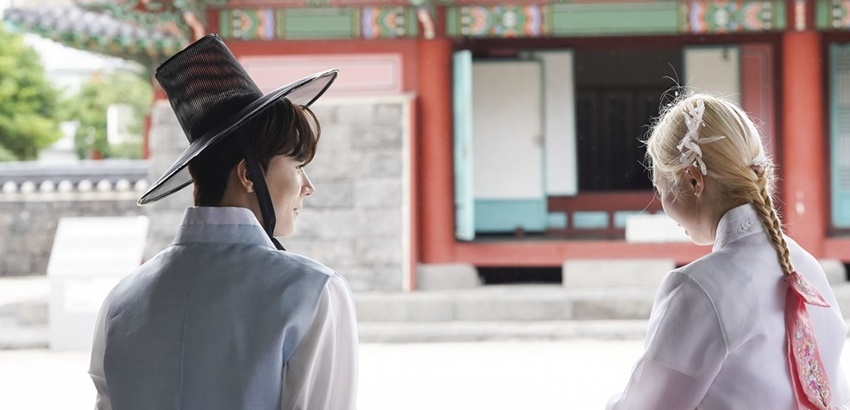
MBTI Traveler of Earth Experience Folk Traditional Jeju

K-drama filming location Welcome to Samdalri
Tourist Destinations

Hallasan Mountain

Hueree Natural Park

Jeju Olle Course 10

Seongsan Ilchulbong Peak

Saebyeol Oreum

Snoopy Garden
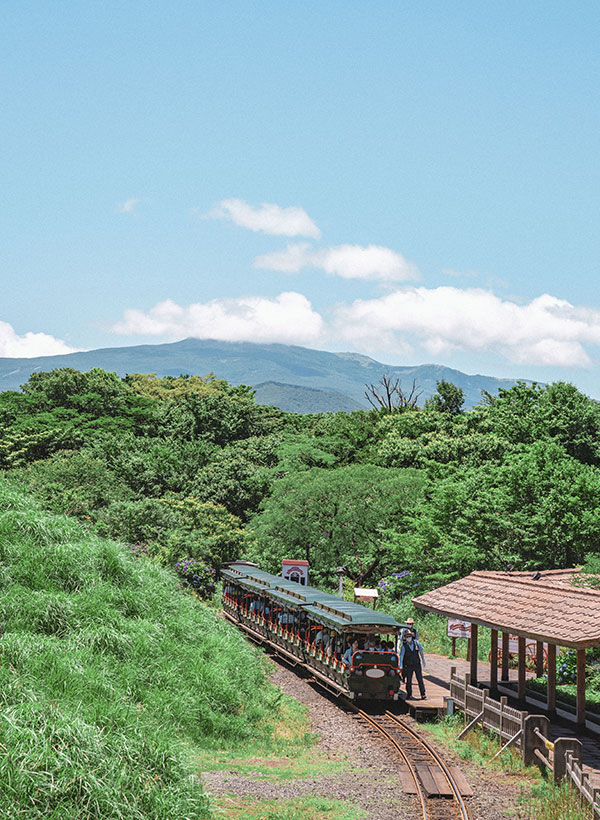
Eco Land Theme Park
Bucket list

Jeju Travel Sharing
Meet Jeju with video @VisitjejuGlobal

Your personalized travel sharing platform @Visitjeju.en
Visit Jeju provides travel information tailored to its users. If you input some basic information below, we will provide you with big data-based recommended travel information.
UN Tourism | Bringing the world closer
Share this content.
- Share this article on facebook
- Share this article on twitter
- Share this article on linkedin
A Real-time Safety and Congestion Level Analysis System for Jeju Tourist Sites
- Asia and the Pacific
The Jeju Tourism Organization, an industry leader in smart tourism, launches a big data-based tourism service platform.

Jeju Special Self-Governing Province and the Jeju Tourism Organization (CEO Koh Eun-Sook) launched a real-time tourist congestion analysis service in December 2020 that actively utilizes big data technology to help Jeju tourists to enjoy their visit without the need to worry about COVID-19.
The service uses data from base stations owned by the telecommunications company SKT to update and provide regional distribution maps by gender and age of residents/tourists every 5 minutes. Users can view places with significant resident and tourist populations in real-time, as well as places that have the greatest increase in traffic in the last 3 hours. Statistics for the last 24 hours are also available to assess the popularity and congestion of each location.
The service provides information for tourists to travel safely and with peace of mind, suggesting visitor times that are less congested. You can find this service on the official Jeju tourism information portal, VisitJeju (visitjeju.net/kr/bigdatamap), operated by the Jeju Tourism Organization. The agency plans to offer it on mobile and as an application in the second half of 2021.
JTO will also support the creation of various tourism businesses that fit individual/non-face-to-face tourism trends. Based on the tourist distribution map, the agency is promoting distributed regional marketing through customized recommendation services for tourists and developing an analysis service that integrates data in the tourism industry.
According to a big data analysis of the moving patterns of Jeju tourists, JTO has established and managed COVID-19 countermeasure clusters that focused on eight major destinations. Similarly, a tourism-related disease prevention system that is tailored to Jeju Island is expected to be more effectively created and operated through this real-time tourist congestion analysis service.
“Our goal is to become a leader in smart tourism with our big data-based tourism service platform. We will continue to meet the needs of residents by helping to revitalize the local economy after the COVID-19 crisis has subsided by providing practical services that are based on an analysis of big data and the statistical management of the tourism industry,” said an official from the Jeju Tourism Organization.
-- Brochure 1
-- Brochure 2
- Updated 2020.11.16 16:45
- All Articles
- Environment
- Photos and videos
- Business news
- Renewable Energy
- Jeju Travel
- Partners and Deals
- Accommodation
- Things To Do
- Jeju Biennale
- Editorials and Opinion
- Junior Journalist
- Guide for Expats
- Health and Leisure
- Food and Drink
- The Jeju Weekly
- Subscribe To Us
As the news sinks in that a second airport will be constructed in Seongsan-eup, southeast Jeju Island, it is clear Jeju tourism has well and truly taken off; what remains unclear is its destination.
With the current airport due to hit capacity by 2018, and the province set on numbers, numbers, numbers, an additional airport was deemed essential for future growth.
With direct flights to Southeast Asia and beyond on the horizon, the current 13 million tourists are expected to rise to 20 million by 2025.
Although a matter of pride for many islanders, we need to talk about where this trajectory ends. This isn’t about a new airport, but the need to accommodate millions more tourists every year, and the hotels, resorts and casinos associated with that.
Some people will just see opportunities here, and for the savvy there will be many, but our concern should be for the capacity of our island’s environment.
Where will 20 million tourists (and more) leave Jeju’s UNESCO Triple Crown, the IUCN World Environmental Capital 2020 bid , or Jeju’s carbon-free status by 2030? (Has Elon Musk invented the carbon-free airplane yet?)
Questioning tourism growth may sound heretical, but exploiting Grandmother Seolmundae’s creation for short-term gain is the true blasphemy, and not in the true interests of Her earthly descendants.
The cash cow is getting milked for all it is worth, and we need brave and creative solutions to both increase tourism revenue, and limit its environmental impact.
Sustainable answers Jeju prides itself on being at the forefront of change — just look at the smart grid, electric vehicles and wind power — but Dr. Ross Dowling, advisor to UNESCO and the Global Geopark Network, says its tourism policy reflects “ last century’s thinking .”
The focus should be qualitative, not quantitative, and this necessitates a rebalancing to add value to Jeju tourism and increase environmental safeguards.
One move in this direction could be the introduction of a tourist ecotax.
First introduced in the Spanish Balearic Islands in 2001-2003, it was reintroduced there again this year. Tourists, including cruise passengers, are charged for entering the islands and the proceeds are used for environmental conservation projects.
If at the correct level, the charge would not only filter low-spending tourists, but also instantly add value to the Jeju brand as a premium eco-destination, with astute businesses positioning themselves accordingly.
Jeju is expecting over 13 million tourists this year, and even if each paid a modest 10,000 won ecotax on entry, 130 billion won would be available for conservation projects.
The proceeds could be used to purchase Jeju’s remaining gotjawal forest habitat, for example, to safeguard it for future generations.
To cap it all off Eventually, we must also broach a sensitive subject — a tourist cap.
While it is far from certain that the current Chinese tourist boom will continue, the growing middle class both there and in Southeast Asia suggests outbound tourists will increase for some time.
When we hear of tourist caps, we think of fragile ecosystems such as the Galapagos or Mt. Everest, but the idea is garnering support from major tourist islands and cities.
This may scare some, but it is actually an opportunity to offset future conflict, and it allows the island to keep control of its own destiny.
Just like an ecotax, the cap would be an instant boost for the island brand, portraying Jeju as a premium destination to be savoured, not devoured.
Iceland is already on this path; after 1 million tourists visited in 2014 — yes, just 1 million — director general of the Icelandic Tourist Board, Ólöf Ýrr Atladóttir, said , "We can’t just endlessly receive more and more people.”
She wants Iceland to control tourism, rather than have tourism control Iceland.
The new mayor of Barcelona, Ada Colau, agrees . She has proposed a moratorium on new hotels and wants a strategic plan to identify the city’s “saturation limit.”
With 9 million tourists expected in the Catalan city in 2015, Colau fears that if the city becomes a “theme park,” people will stop coming. (Jeju, are you listening?)
Even small islands long down the mass-tourism road are having second thoughts.
President Fernando Clavijo of the Canary Islands wants to limit numbers while increasing spend per tourist.
After welcoming 13 million tourists in 2014 — a number Jeju can expect this year — he said that mass tourism could “end up killing our added value.”
Even the poster childs of Jeju development are mulling limiting visitor numbers.
A former Bali tourism minister said that “the island must enforce a limit on the number of tourists” to protect local nature and culture.
Hong Kong has already increased restrictions for visitors from the Chinese mainland, and Macau tightened visa regulations in 2014, before relaxing them again after a drop in casino takings.
An opportunity, not a threat A cap on tourists would not only allow Jeju to retain some of its character and environment, it would also force policymakers to focus on how to increase spend-per-tourist, a blue ocean for Jeju tourism.
With many tourists still coming on group tours, much spent here leaves the island for Seoul or Beijing.
Yonhap reported in 2010 that 55 percent of tourist revenue left the island (“leakage”), which is on a par with developing countries. Advanced economies achieve a rate of just 10 to 20 percent.
Rather than building more beds and bringing more tourists in, the island must focus on getting the tourists already here to spend more, and to spend locally and sustainably.
By refocusing Jeju tourism policy in this way, the potential for qualitative growth is huge, and the only sustainable option.
The province must act now Crucially, Jeju must act now and, like Barcelona, identify its “saturation point.” This will allow business to adapt in advance of the cap, and safeguard the island’s character and environment for the next generation.
European destinations not heeding these warnings have paid the price. Mass tourism has ruined many Mediterranean resorts, something known as “the Magaluf effect” after one of Spain’s least desirable destinations.
Jeju is no Magaluf, and I believe we have people with the vision to draw up a sustainable tourism model not only for 2025, but for 2050 and beyond.
And by that time, I hope destinations around the world are talking of “the Jeju effect,” as they herald the success of our sustainable tourism model.
- About the paper
- Advertising
- Privacy Policy
- youth protection policy
- E-mail address privacy
Mail to [email protected] | Phone: +82-64-724-7776 Fax: +82-64-724-7796 #505 jeju Venture Maru Bldg,217 Jungangro(Ido-2 dong), Jeju-si, Korea, 690-827 Registration Number: Jeju Da 01093 | Date of Registration: November 20, 2008 | Publisher: Hee Tak Ko | Youth policy: Hee Tak Ko C o pyright ⓒ 2009 All materials on this site are protected under the Korean Copyright Law and may not be reproduced, distributed, transmitted, displayed, published without the prior consent of jeju weekly.com.

- Testimonials
- Meet the Team
- Work With Us
- Outlook Features
- Sign Up Today
- Travel Guides
- Middle East
Jeju Island Travel Guide

The Northeast Asian Island of Jeju is an awe-inspiring land of natural wonders. The ultimate honeymoon getaway, discover South Korea’s answer to paradise.
JEJU ISLAND
‘Island of the Gods’, the volcanic land mass of Jeju, known locally as Jeju-do, has long attracted crowds of vacationers and honeymooners, and is well-established as the ideal hideaway for Korean newlyweds.
Rising up from the depths of the Korean Peninsula as Korea’s largest and southernmost island, Jeju’s serene, crater-marked landscape and mild sub-tropical climate is blessed with a natural beauty ideal for hikers and a new wave of wellness tourism.
Indeed, Jeju is officially recognised by UNESCO as a World Natural Heritage Site, Global Geopark and Biosphere Reserve, encompassing Korea’s highest peak of Hallasan Mountain, the vast forested swathes of a semi-tropical national park, a wild coastline and the world’s longest underground lava tube.
The island is known for its unique cuisine, most notably the local seafood caught by Jeju’s famous female deep-sea divers (haenyeo), all of whom are aged 60 and over. Jeju’s beaches are perfectly suited for some coastal relaxation, its idyllic waters cloaking vivid seascapes of coral. Further inland, you will find narrow lanes lined with traditional cottages rendered from the native black lava rock, while fertile volcanic soils support palm trees, flourishing mandarin groves, pineapples and exotic dragon fruit.
After arriving in the island’s main urbane hub of Jeju City, Jeju’s southern coast is the most developed for tourism. But hire a car to venture to Jeju’s more remote areas, and you will find a land that appears untouched for decades. Watch the sunrise from volcanic craters, explore towering waterfalls and unwind in a natural paradise.

“We are developing and implementing an integrated grassroots tourism brand which brings locals and visitors together” Eun-sook Koh, CEO, JTO
TOURISM INSIGHTS: JEJU TOURISM ORGANISATION
The Jeju Tourism Organization (JTO) is the official body tasked with the promotion of tourism in Jeju. Now rising from the ashes as one of the regions hit hardest by the COVID-19 pandemic, the JTO is leading Jeju’s resurgence as an attractive destination for wellness tourism in 2022. Aside from this, the JTO is dedicated to establishing an eco-system of sustainable, resident-led tourism that flourishes in alignment with the protection of the island’s natural environment. The JTO’s CEO, Ms. Eun-sook Koh , tells us more.
Q&A WITH MS. EUN-SOOK KOH, CEO, JEJU TOURISM ORGANISATION
What role does the Jeju Tourism Organization play in tourism on Jeju Island and what public services do you offer?
Ms. Eun-sook Koh, CEO (EK): In order to help stabilise the Jeju tourism market and realise the sustainability of the local industry, the Jeju Tourism Organization (JTO) is working to improve the overall structure of the island’s brand as a global tourism destination. This involves fostering a premium tourism environment and developing customised marketing to match conditions on the ground.
The JTO provides a number of public services. These include integrated public relations marketing, product and resource development, conducting research on the tourism industry, improving preparations to receive visitors, expanding Jeju’s tourism information platform, as well as providing tourism industry training and consulting services.
How has COVID-19 affected the tourism industry in Jeju, and what do you expect for the future after the pandemic?
EK: As we’ve seen all around the globe, the tourism industry has been hit hard by the COVID-19 pandemic. Here on Jeju Island, our economy shrank by nine percent while the service productivity index dropped 13.6 percent. This is indicative of the importance of tourism to Jeju’s bottom line and thus we were among the regions hardest hit by the pandemic nationwide.
In 2019, the Jeju tourism market greeted a record 15.2 million visitors (13.5 million domestic travellers, or 88.7 percent of that total, and 1.7 million overseas visitors). The overseas tourism market was mainly focused on geographically close markets such as Japan and other countries in the region, particularly China. This obviously took a massive hit with pandemic-related restrictions on international arrivals, but we expect these numbers to recover as the world transitions to a “with COVID” era.
Why, in your opinion, should someone visit Jeju Island?
EK: Jeju has the most to offer as a holiday destination in Northeast Asia. It is Korea’s largest and southernmost island beloved for its natural beauty. Three times the size of Guam, Jeju has a mild subtropical climate and a massive national park that preserves the island’s most important (and revered) geological formation — Hallasan Mountain (1,950 metres).
UNESCO has recognised Jeju as a World Natural Heritage site and Biosphere Reserve, and more recently we gained membership in the Global Geoparks Network. Jeju is the most preferred resort and tourist destination for relaxation, healing, and affordable holidays in Korea.
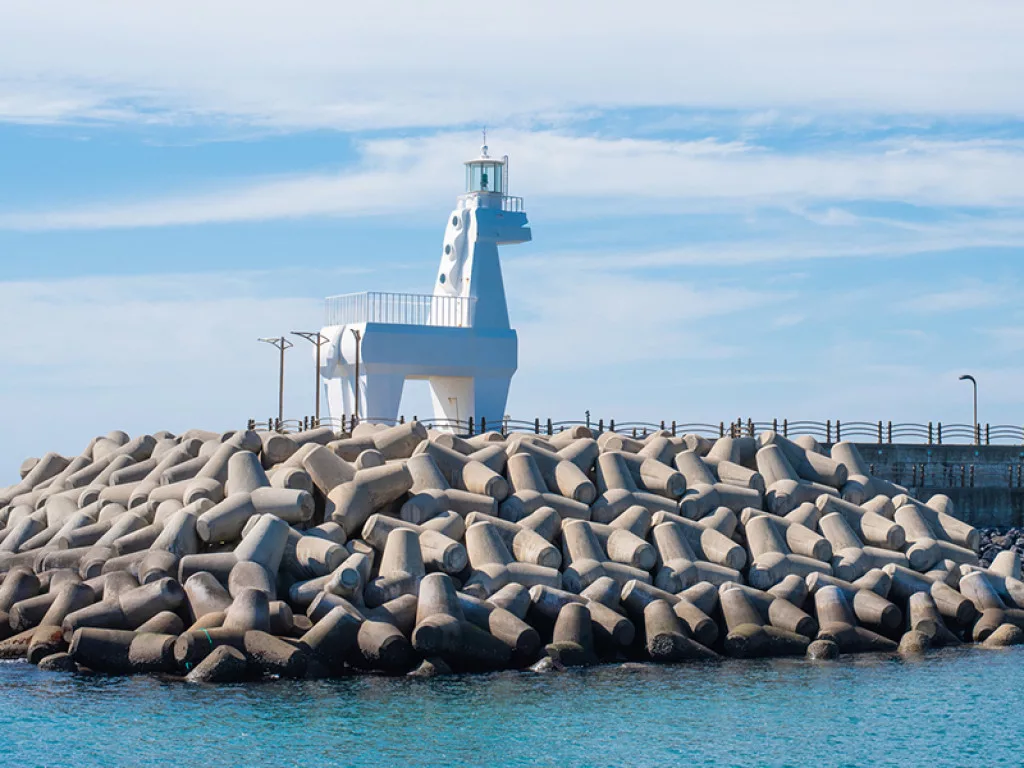
What projects are JTO developing for the tourism industry?
EK: The JTO is devoting itself to creating a sustainable, resident-led local tourism ecosystem that functions in harmony with the interests of preserving Jeju’s natural environment. We are developing and implementing an integrated grassroots tourism brand which brings locals and visitors together. The establishment of Jeju wellness tourism benefits everyone by creating jobs which put locals front-and-centre, while also exposing visitors to Jeju’s rich culture—all in a virtuous cycle of sustainability.
The JTO sees wellness tourism as an essential part of the island’s post-COVID recovery. This is a core industry that requires public-private partnerships and cooperative projects to improve local tourism at an institutional level. We are also looking at ways to cultivate new talent, create jobs, foster innovative research, and establish a range of Jeju-style wellness tourism destinations and brands. The JTO is also reaching out to international networks and embracing global standards and international certifications.
In addition, we are expanding our one-stop tourism information platform — VisitJeju.net — to provide a wide range of online tourism-oriented services. Our domestic- and international-targeted social media channels (YouTube, Facebook, Instagram, etc.) are promoting Jeju with an ever-growing archive of informative articles and videos. We are also working with a range of influencers to produce exciting new video content, as well as developing and operating a “virtual” travel programme linked with global over-the-air programming (OTA).
OUTLOOK RECOMMENDS
For Authentic Korean Street Food…
In the bustling heart of Jeju City, Dongmun Traditional Market is the island’s largest and oldest permanent market. Here you will find a plentiful bounty of authentic Korean fare, from seafood to Jeju’s famous local mandarins. Open until midnight and located close to Jeju International Airport, be sure to stop by for some last-minute souvenirs.
For the best local delicacies…
Many first-time visitors on Jeju come in search of the island’s delicious black pork. The meat tastes even better if you eat it with Mel-jeot, which is a salted anchovy that reduces the pork’s oiliness and makes it tastier. For seafood, Jeon-bok (abalone) is so nutritious that it is also known as the wild ginseng of the sea. Many abalones are gathered from Jeju waters and it can be found in many delicacies. It is usually prepared as porridge and various other stews.
For exploring the island on foot…
As Korea’s national pastime, you would be amiss to visit Jeju without going hiking. The Olle coastal trails circle most of the island and are a fantastic way to explore Jeju’s rugged coastline with long distance routes or easily navigable shorter sections. Home Comforts Hiking offer a fantastic selection of guided hiking tours that can be booked through their website.
For an unforgettable sunrise…
Seongsan Ilchulbong, otherwise known as ‘Sunrise Peak’, is the best spot to observe Jeju’s breath-taking sunrises. Located on Jeju’s eastern side, the peak enjoys the earliest dawn and even hosts a sunrise festival every New Year’s Eve. A hike to the summit should take no longer than 45 minutes along a paved, albeit steep, stepped path.
For a first-class resort…
Found in the Jungmun resort area of southwestern Jeju, The Shilla Jeju boasts ultimate comfort with all the amenities for a relaxing stay, including immediate beach access and sophisticated modern décor. From some rooms, you can even enjoy views of Hallasan Mountain towering in the distance.
For a peaceful temple stay…
Temple stays offer a fantastic traditional experience in Jeju for those willing to go without Western amenities. Enjoy meditation, grounds-sweeping and tea ceremonies. However, be warned since most stays typically include a pre-dawn wake up call! Visit eng.templestay.com for English-speaking options.
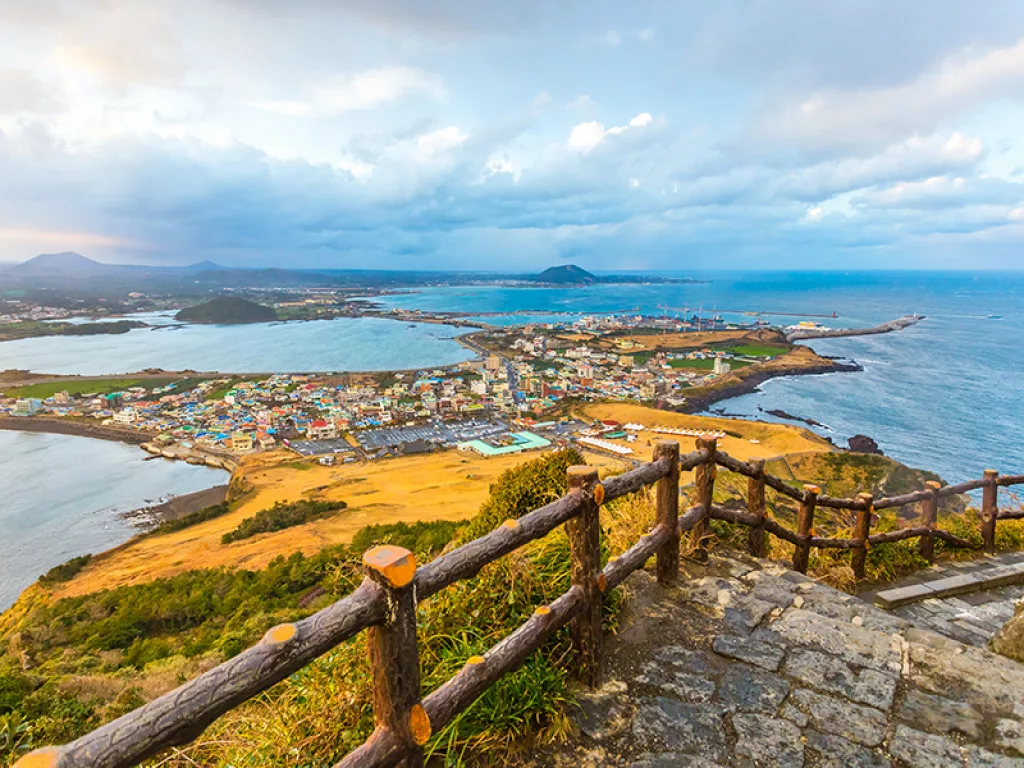
SEOGWIPO IN FOCUS
Jeju hosts two regional cities; Jeju City, and the southern hub of Seogwipo. Seogwipo offers a quieter, more secluded alternative to Jeju City and is the perfect gateway to exploring the volcanic southern coast. The city is easily covered on foot, with downtown Seogwipo hosting the traditional Olle Market.
Seogwipo is surrounded by lush gardens and citrus farms bordered with fences made from the local black rock. Nearby attractions include the Jeongbang Falls, as the only waterfall in Asia that pours directly into the ocean. Similarly, Cheonjiyeon Pokpo is another jaw-dropping waterfall that can be reached by a short hike through a scenic forested gorge. Both falls can be found on the Olle Trail Six, or by taking a city tour bus from central Seogwipo.
Blessed with clear waters and mild ocean temperatures, Jeju’s second-largest city is also popular for its scuba-diving opportunities, boat trips and submarine tours.
The Mermaids of Jeju
Alongside the Jungmun Resort area, Seogwipo is one of the best places to observe the iconic deep-sea divers of Jeju at work. Otherwise known as haenyeo, these free divers are all aged 60 plus, with a minority still diving well into their eighties, and are an iconic and unique feature of Jeju’s cultural history.
Women began diving off the island for food when Jeju’s menfolk would disappear for weeks at a time on fishing boats. Without the use of any breathing apparatus, haenyeo continue to dive to depths of between 10 and 20 metres in wetsuits searching for the likes of octopus, abalone, clams and seaweed. This seafood provides an essential food source, particularly since the Asian staple of rice is unable to grow on Jeju’s wild and windy shores.
Although the haenyeo are a rarer phenomenon today, they remain a source of renown throughout the country.
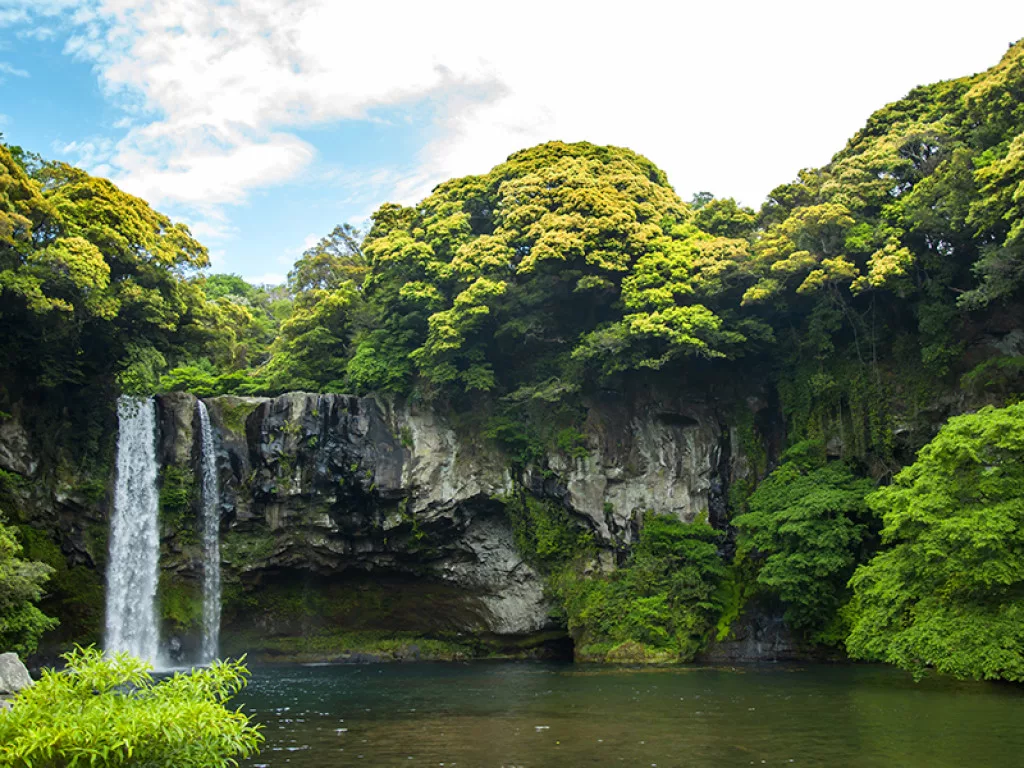
LANDMARK ATTRACTIONS
Grandfather Stones
The distinctive ‘grandfather stones’ of Jeju are manmade landmarks hewn from pillars of black rock by local masons over the centuries. 45 original statues still exist across the island and are Jeju’s equivalent of the iconic Easter Island moai. Phallic in appearance, legend has it that the stones were originally constructed as harbingers of fertility.
Hallasan Mountain
The dormant volcano of Hallasan towers at a height of 1,950 metres above sea level and represents a challenging feat for keen hikers looking for a rewarding day’s climb. This UNESCO Biosphere Reserve comprises a crater lake, alpine plants and local wildlife including woodpeckers, chipmunks and butterflies. In spring, the mountain is particularly picturesque, carpeted in pink azaleas.
Manjanggul Lava Tubes
A UNESCO World Natural Heritage site, the Manjanggul Lava Tubes are the gateway to the longest underground lava tube in the world. Formed from cooled volcanic lava, the network stretches five miles underground and offers a fantastic subterranean glimpse of stalactites, stalagmites, cave coral and lava bridges.
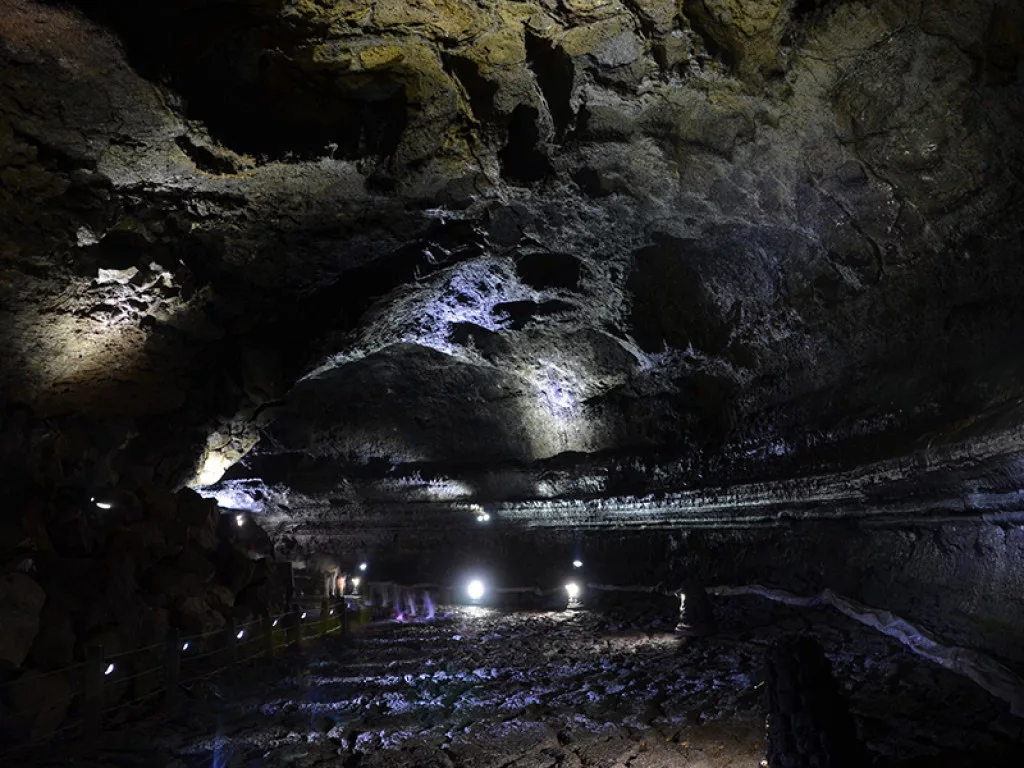
GETTING THERE AND AROUND
At less than 70 kilometres long, travel times for traversing Jeju can still be long, particularly if travelling by bus. Renting a car is a popular choice of transport for getting around Jeju, with bike rentals available in many smaller locations. Longer distance bike trips are a great way to explore the perimeters of the island, along mainly empty scenic roads. Allowing four to five days to complete the full circuit, keen cyclists may choose to plan a trip taking in overnight stops in booked Airbnb rooms along the way.
Buses and taxis are the main source of public transport in the metropolitan areas of Jeju City and Seogwipo. Arriving into Jeju City, the island is easily accessed with regular direct flights from international cities including Shanghai, Beijing, Tokyo and Osaka, as well as South Korea’s domestic airports.
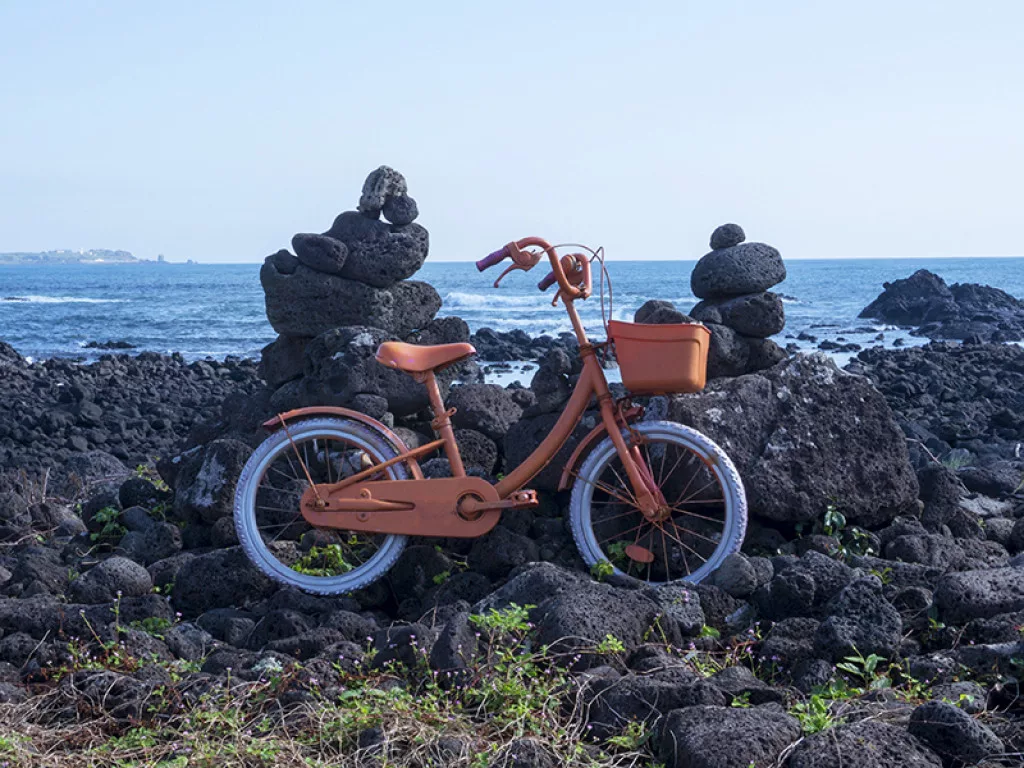
More Asia Travel Guides

Bali Travel Guide
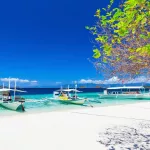
Philippines Travel Guide
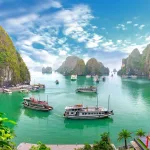
Vietnam Travel Guide
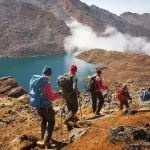
Nepal Travel Guide
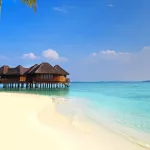
Maldives Travel Guide
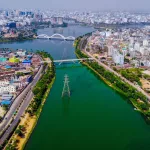
Bangladesh Travel Guide
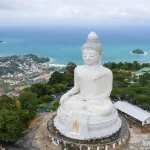
Phuket Travel Guide
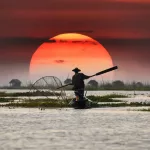
Myanmar Travel Guide
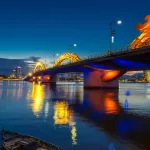
Danang Travel Guide
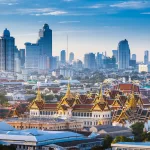
Thailand Travel Guide

Jordan Banks : Behind the Lens


Tootbus : Travel Business

Queensland Indigenous Womens Ranger Network

Under SXM : Creating Sustainable Underwater Experiences

Hidden Spots for Cherry Blossom Season : Round Up

Urbino : The Last Stop

Enrico Costantini : Behind the Lens

Lepogo Lodges : A Sustainable Safari Experience

Casa de Olivos : Sustainability Stories

Opulence on the Orient Express
Sign in to your account
Username or Email Address
Remember Me

- Language Language Korean English Chinese Japanese Vietnamese Indonesian Thai Spanish go
- Main Business
- How to Get Here
- Bio Sphere Reserve
- Natural Heritage Site
- Jeju Island Global Geopark
- The New 7 Wonders of Nature
- The Legend of Jeju´s Origin
- Folk of Jeju
- Food, Lodging and Clothing
- History of Jeju
Photo Gallery

- Tourist Information
- Multimedia Contents Gallery
- Promotion library & E-Book

COPYRIGHT ⓒ JEJU TOURISM ORGANIZATION. ALL RIGHTS RESERVED.
Jeju Island Travel Guide
Book your individual trip , stress-free with local travel experts
- roughguides.com
- South Korea
- jeju-island
- Travel guide
- Local Experts
- Travel Advice
- Accommodation
Plan your tailor-made trip with a local expert
Book securely with money-back guarantee
Travel stress-free with local assistance and 24/7 support
The mass of islands draping off Korea’s southern coast fades into the Pacific, before coming to an enigmatic conclusion in the crater-pocked JEJU ISLAND , known locally as Jejudo (제주도). This tectonic pimple in the South Sea is the country’s number-one holiday destination, particularly for Korean honeymooners, and it’s easy to see why – the volcanic crags, innumerable beaches and colourful rural life draw comparisons with Hawaii and Bali, a fact not lost on the local tourist authorities. This very hype puts many foreign travellers off, but while the five-star hotels and tour buses can detract from Jeju’s natural appeal, the island makes for a superb visit if taken on its own terms; indeed those who travel into Jeju’s more remote areas may come away with the impression that little has changed here for decades. In many ways it’s as if regular Korea has been given a makeover – splashes of tropical green fringe fields topped off with palm trees and tangerine groves, and while Jeju’s weather may be breezier and damper than the mainland, its winter is eaten into by lengthier springs and autumns, allowing oranges, pineapples and dragon fruit to grow.
Eastern Jeju
Grandfathers of rock, hallasan national park, the waterfalls, western jeju.
Around the island, you’ll see evidence of a rich local culture quite distinct from the mainland, most notably in the form of the hareubang – these cute, grandfatherly statues of volcanic rock were made for reasons as yet unexplained, and pop up all over the island. Similarly ubiquitous are the batdam, walls of hand-stacked volcanic rock that separate the farmers’ fields: like the drystone walls found across Britain, these were built without any bonding agents, the resulting gaps letting through the strong winds that often whip the island. Jeju’s distinctive thatch-roofed houses are also abundant, and the island even has a breed of miniature horse; these are of particular interest to Koreans due to the near-total dearth of equine activity on the mainland. Also unique to Jeju are the haenyeo , female divers who plunge without breathing apparatus into often treacherous waters in search of shellfish and sea urchins. Although once a hard-as-nails embodiment of the island’s matriarchal culture, their dwindling numbers mean that this occupation is in danger of petering out.
Jeju City is the largest settlement, and whether you arrive by plane or ferry, this will be your entry point. You’ll find the greatest choice of accommodation and restaurants here, and most visitors choose to hole up in the city for the duration of their stay, as the rest of the island is within day-trip territory. Although there are a few sights in the city itself, getting out of town is essential if you’re to make the most of your trip. On the east coast is Seongsan , a sumptuously rural hideaway crowned by Ilchulbong, a green caldera that translates as “Sunrise Peak”; ferries run from here to Udo , a tiny islet that somehow manages to be yet even more bucolic. Inland are the Manjanggul lava tubes , one of the longest such systems in the world, and Sangumburi , the largest and most accessible of Jeju’s many craters. All roads eventually lead to Seogwipo on the south coast; this relaxed, waterfall-flanked city is Jeju’s second-largest settlement, and sits next to the five-star resort of Jungmun . Sights in Jeju’s west are a little harder to access, but this makes a trip all the more worthwhile – the countryside you’ll have to plough through is some of the best on the island, with the fields yellow with rapeseed in spring, and carpeted from summer to autumn with the pink-white-purple tricolour of cosmos flowers. Those with an interest in calligraphy may want to seek out the remote former home of Chusa, one of the country’s most famed exponents of the art. In the centre of the island is Hallasan , an extinct volcano and the country’s highest point at 1950m, visible from much of the island, though often obscured by Jeju’s fickle weather.
Jeju is one of the few places in Korea where renting a car or bicycle makes sense. Outside Jeju City, roads are generally empty and the scenery is almost always stunning, particularly in the inland areas, where you’ll find tiny communities, some of which will never have seen a foreigner. Bicycle trips around the perimeter of the island are becoming ever more popular, with riders usually taking four days to complete the circuit – Seongsan, Seogwipo and Daecheong make logical overnight stops.
Brief history
Jejudo burst into being around two million years ago in a series of volcanic eruptions, but prior to an annexation by the mainland Goryeo dynasty in 1105 its history is sketchy and unknown. While the mainland was being ruled by the famed Three Kingdoms of Silla, Baekje and Goguryeo, Jeju was governed by the mysterious Tamna kingdom , though with no historical record of Tamna’s founding, it is left to Jeju myth to fill in the gaps: according to legend, the three founders of the country – Go, Bu and Yang – rose from the ground at a spot now marked by Samseonghyeol shrine in Jeju City. On a hunting trip shortly after this curious birth, they found three maidens who had washed up on a nearby shore armed with grain and a few animals; the three fellows married the girls and using the material and livestock set up agricultural communities, each man kicking off his own clan. Descendants of these three families conduct twice-yearly – in spring and autumn – ceremonies to worship their ancestors.
More prosaically, the Samguk Sagi – Korea’s main historical account of the Three Kingdoms period – states that Tamna in the fifth century became a tributary state to the Baekje kingdom on the mainland’s southwest, then hurriedly switched allegiance before the rival Silla kingdom swallowed Baekje whole in 660. Silla itself was consumed in 918 by the Goryeo dynasty, which set about reining in the island province; Jeju gradually relinquished autonomy before a full takeover in 1105. The inevitable Mongol invasion came in the mid-thirteenth century, with the marauding Khaans controlling the island for almost a hundred years. The horses bred here to support Mongol attacks on Japan fostered a local tradition of horsemanship that continues to this day – Jeju is the only place in Korea with significant equine numbers – while the visitors also left an audible legacy in the Jejanese dialect.
In 1404, with Korea finally free of Mongol control, Jeju was eventually brought under control by an embryonic Joseon dynasty . Its location made it the ideal place for Seoul to exile radicals. Two of the most famed of these were King Gwanghaegun , the victim of a coup in 1623, and Chusa , an esteemed calligrapher whose exile site can be found on the west of the island. It was just after this time that the West got its first reports about Korea, from Hendrick Hamel , a crewman on a Dutch trading ship that crashed off the Jeju coast in 1653.
With Jeju continually held at arm’s length by the central government, a long-standing feeling of resentment against the mainland was a major factor in the Jeju Massacre of 1948. The Japanese occupation having recently ended with Japan’s surrender at the end of World War II, the Korean-American coalition sought now to tear out the country’s Communist roots, which were strong on Jejudo. Jejanese guerrilla forces, provoked by regular brutality, staged a simultaneous attack on the island’s police stations. A retaliation was inevitable, and the rebels and government forces continued to trade blows years after the official end of the Korean War in 1953, by which time this largely ignored conflict had resulted in up to thirty thousand deaths, the vast majority on the rebel side.
Things have since calmed down significantly. Jeju returned to its roots as a rural backwater with little bar fishing and farming to sustain its population, but its popularity with mainland tourists grew and grew after Korea’s took off as an economic power, with the island becoming known for the samda , or three bounties – rock, wind and women. Recently tourist numbers have decreased slightly, with richer and more cosmopolitan Koreans increasingly choosing to spend their holidays abroad, though Jeju still remains the country’s top holiday spot.
Tailor-made travel itineraries for South Korea, created by local experts

14 days / from 3800 USD
Culture & Island life
Experience the highlights of Korea with a private guide by your side. Fascinating Seoul with a day trip to the DMZ, followed by days in Gyeongju and Busan. Afterwards, leave the mainland and fly to Jeju Island. Enjoy the crystal blue waters and island culture.

11 days / from 2400 USD
Highlights of Korea
From the skyscrapers of Seoul to traditional villages - this itinerary packs culture, history and cuisine in one compact itinerary. Enjoy a two-night temple stay as well as in-depth guided excursions in Seoul, Gyeongju, Yeosu, and Jeonju.

7 days / from 1950 USD
Temples and Nature in Korea
Start your Korean adventure in Busan. Continue to Yeosu and Suncheon, discovering temples and landscapes on the way. In Suncheon, you will stay at a Korean Buddhist temple. Proceed to the Bamboo Forest of Jeonju before heading to Seoul.
The eastern half of Jeju is wonderfully unspoilt – the coast is dotted with unhurried fishing villages, while inland you can see evidence of Jeju’s turbulent creation in the form of lava tubes and volcanic craters. Buses to the region leave Jeju City with merciful swiftness, passing between the sea and lush green fields, the latter bordered by stacks of batdam . Seongsan , on the island’s eastern tip, is the most attractive of Jeju’s many small villages, crowned by the majestic caldera of Ilchulbong .
Just offshore is Udo , a bucolic island whose sedentary pace tempts many a visitor to hole up for a few days. A cluster of natural attractions can be found south of the port village of Gimnyeong, most notably Manjanggul , which are some of the world’s longest underground lava tubes. Further south again, Route 97 heads southeast from Jeju City across the island’s interior, running past Sangumburi , a large, forested volcanic crater, and two rewarding folk villages : one a working community with a patchwork of traditional thatch-roofed houses, the other an open-air museum which – though devoid of inhabitants – provides a little more instruction on traditional Jeju life.
A short way east of Jeju City, a group of natural attractions provide an enjoyable day-trip. Foremost among them is Manjanggul (만장굴), a long underground cave formed by pyroclastic flows. Underwater eruptions millions of years ago caused channels of surface lava to crust over or burrow into the soft ground, resulting in subterranean tunnels of flowing lava. Once the flow finally stopped, these so-called “ lava tubes ” remained. Stretching for at least 9km beneath the fields and forests south of the small port of Gimnyeong, Manjanggul is one of the longest such systems in the world, though only 1km or so is open to the public. This dingy and damp “tube” contains a number of hardened, lava features including balls, bridges and an 8m-high pillar at the end of the course.
With a volcanic crater to see and two folk villages to explore, rural Route 97 – also known as the East Tourist Road – is a delightful way to cut through Jeju’s interior. All three attractions can be visited on a day-trip from Jeju City, or as part of a journey between the capital and Seogwipo on the south coast, though it pays to start reasonably early.
Heading south from Jeju City on Route 97, the first place worth stopping is Sangumburi (산굼부리), one of Jeju’s many volcanic craters ; possibly its most impressive, certainly its most accessible, though currently the only one you have to pay to visit. Hole lovers should note that this particular type is known as a Marr crater, as it was produced by an explosion in a generally flat area. One can only imagine how big an explosion it must have been – the crater, 2km in circumference and 132m deep, is larger than Hallasan’s. A short climb to the top affords sweeping views of some very unspoilt Jejanese terrain; peaks rise in all directions, with Hallasan 20km to the southwest, though not always visible. The two obvious temptations are to walk into or around the rim, but you must refrain from doing so in order to protect the crater’s wildlife – deer and badgers are among the species that live in Sangumburi. Consequently there’s not an awful lot to do here, though there’s a small art gallery on site.
Seong-eup Folk Village
A twenty-minute bus ride south of Sangumburi brings you to dusty Seong-eup Folk Village (성읍 민속 마을), a functioning community living in traditional Jeju-style housing, where you’re free to wander among the thatch-roofed houses at will; the residents, given financial assistance by the government, are long used to curious visitors nosing around their yards. Here you’ll see life carrying on as if nothing had changed in decades – farmers going about their business and children playing while crops sway in the breeze. Most visitors spend a couple of pleasant hours here, and if you’re lucky you’ll run into one of the few English-speaking villagers, who act as guides.
Jeju Folk Village and around
Route 97 buses terminate near the coast at the Jeju Folk Village (제주 민속 마을). This coastal clutch of traditional Jeju buildings may be artificial, but provides an excellent complement to the Seong-eup village to its north. Information boards explain the layout and structures of the buildings, as well as telling you what the townsfolk used to get up to before selling tea and baggy orange pants to tourists. The differences between dwellings on different parts of the island are subtle but interesting – the island’s southerners, for example, entwined ropes outside their door with red peppers if a boy had been born into their house.
You’re unlikely to be disappointed by SEONGSAN (성산), an endearing rural town with one very apparent tourist draw looming over it: Ilchulbong (일출봉), or “Sunrise Peak”, is so named as it’s the first place on the island to be lit up by the orange fires of dawn. The town can easily be visited as a day-trip from Jeju City but many visitors choose to spend a night here, beating the sun out of bed to clamber up the graceful, green slope to the rim of Ilchulbong’s crown-shaped caldera. It’s an especially popular place for Koreans to ring in the New Year – a small festival celebrates the changing of the digits. From the town it’s a twenty-minute or so walk to the summit; a steep set of steps leads up to a 182m-high viewing platform at the top, and although the island’s fickle weather and morning mists usually conspire to block the actual emergence of the sun from the sea, it’s a splendid spot nonetheless. Powerful bulbs from local squid boats dot the nearby waters; as the morning light takes over, the caldera below reveals itself as beautifully verdant, its far side plunging sheer into the sea – unfortunately, it’s not possible to hike around the rim. If you turn to face west, Seongsan is visible below, and the topography of the surrounding area – hard to judge from ground level – reveals itself.
Besides the conquest of Ilchulbong, there’s little to do in Seongsan bar strolling around the neighbouring fields and tucking into a fish supper, though the waters off the coast do offer some fantastic diving opportunities. South of town is Sinyang Beach , where the water depth and incessant wind make it a good place to windsurf; equipment is available to rent.
Visible from Ilchulbong is UDO (우도), a rural speck of land whose stacked-stone walls and rich grassy hills give it the air of a Scottish isle transported to warmer climes. Occasionally, the nomenclature of Korea’s various peaks and stony bits reaches near-Dadaist extremes; “Cow Island” is one of the best examples, its contours apparently resembling the shape of resting cattle. This sparsely populated dollop of land is a wonderful place to hole up for a few days, and one of the best places to spot two of Jeju’s big draws – the stone walls (밭담; batdam ) that line the island’s fields and narrow roads, and the haenyeo , female divers long famed for their endurance.
Other than these – and the diving grannies are almost impossible to spot these days – there are very few tourist sights on Udo. Those that do exist can be accessed on the tour buses that meet the ferries. Usually under the direction of charismatic local drivers, they first stop at a black-sand beach for half an hour or so, which allows just enough time to scamper up the hill to the lighthouse for amazing views that show just how rural Udo really is. The buses stop at a small natural history museum – whose second floor is home to some interesting haenyeo paraphernalia – and continue past Sanhosa beach before returning to the ferry terminal.
What is it with Pacific islands and statues? The moai of Easter Island are the most famous, but similar relics have been found on Fiji, Tahiti, Hawaii and Okinawa, among other places. Jeju’s own version is the dolhareubang , or “ stone grandfather ”. Commonly abbreviated to hareubang (하르방), they can be found all over Korea – nowadays usually outside fish restaurants wishing to drum up custom. Bulgy-eyed and often cheery, they differ from their Polynesian counterparts by being quite expressive. Their hands rest on their tummies as if full of food; those with left above right are said to be military, as opposed to the more scholarly right-above-left brigade.
Like the moai , the origin and purpose of the statues remain shrouded in mystery, though it seems likely that they were placed at village entrances as a means of protection. Another theory, and one supported by their extremely phallic appearance , is that they served as sources of fertility – today, miniature versions are sold to women who are having trouble getting pregnant, as well as tourists wanting a souvenir of their trip to Jeju.
Today, only a few dozen authentic hareubang remain; the most accessible can be found in Jeju City, at the entrance to the Folklore and Natural History Museum, and outside Samseonghyeol.
Arriving by ferry on a clear day, you can see the whole of Jeju tapering slowly to Mount Halla, known locally as HALLASAN (한라산), a dormant volcano at the centre of the island, and Korea’s highest point at 1950m. Blanketed with pink azalea in the spring, and snow in the winter, the centre of the island has long been a national park , with four well-trodden hikes heading to Hallasan’s crater, a grassy bowl pocked with grey volcanic rocks, and home to a couple of small lakes. As long as the weather cooperates, a climb up Hallasan is one of the main goals for adventurous visitors from the mainland. The four main routes , starting from the north and heading clockwise, are Gwanamsa, Seongpanak, Yeongsil and Eorimok.
JEJU CITY ( jeju-shi ; 제주시) is the provincial capital and home to more than half of its population. Markedly relaxed and low-rise for a Korean city, and loomed over by the extinct volcanic cone of Hallasan, it has a few sights of its own to explore, though palm trees, beaches, tectonic peaks and rocky crags are just a bus-ride away, thus making it a convenient base for the vast majority of the island’s visitors.
Jeju City was, according to local folklore, the place where the island’s progenitors sprung out of the ground (you can still see the holes at Samseonghyeol ), and while there are few concrete details of the city’s history up until Joseon times, the traditional buildings of Mokgwanaji , a governmental office located near the present centre of the city, shows that it has long been a seat of regional power. Other interesting sights include Yongduam (“Dragon Head Rock”), a basalt formation rising from the often fierce sea, and Jeju Hyanggyo , a Confucian academy. There are also a couple of vaguely interesting museums, best reserved as shelter on one of Jeju’s many rainy days. South of the centre along the Mysterious Road , where objects appear to roll uphill, is the entertainingly racy Love Land .
Jeju’s diving grannies
It may be hard to believe in a place that once was, and in many ways still is, the most Confucian country on earth, but for a time areas of Jeju had matriarchal social systems. This role reversal is said to have begun in the nineteenth century as a form of tax evasion, when male divers found a loophole in the law that exempted them from tax if their wives did the work. So were born the haenyeo (해녀), literally “ sea women ”; while their husbands cared for the kids and did the shopping, the females often became the breadwinners, diving without breathing apparatus for minutes at a time in search of shellfish and sea urchins. With women traditionally seen as inferior, this curious emancipation offended the country’s leaders, who sent delegates from Seoul in an attempt to ban the practice. It didn’t help matters that the haenyeo performed their duties clad only in loose white cotton, and it was made illegal for men to lay eyes on them as they worked.
Today, the haenyeo are one of Jeju’s most famous sights. Folk songs have been written about them, their statues dot the shores, and one can buy postcards, mugs and plates decorated with dripping sea sirens rising from the sea. This romantic vision, however, is not entirely current; the old costumes have now given way to black wetsuits, and the haenyeo have grown older: even tougher than your average ajumma , many have continued to dive into their 70s. Modern life is depleting their numbers – there are easier ways to make money now, and few families are willing to encourage their daughters into what is still a dangerous profession. The figures peaked in the 1950s at around thirty thousand, but at the last count there were just a few hundred practising divers, the majority aged over 50. Before long, the tradition may well become one of Jeju’s hard-to-believe myths.
Korea’s most exclusive resort curls along a beautiful beach west of Seogwipo, a place where expense-account tourists come from the mainland and abroad to play a few rounds of golf, shop for designer bags or relax in five-star pools in between business conventions. However, to write off JUNGMUN (중문) on account of this would be a mistake – the surrounding area has the island’s greatest and most varied concentration of sights, accessible on any budget, and can even credibly claim to possess the most distinctive temple, gallery and museum of Korea’s inexhaustible collection – all this shoehorned amid beaches, gardens and waterfalls.
Teddy Bear Museum
Although it may sound like the epitome of Jeju tack, the Teddy Bear Museum (테디베어 박물관) impresses even its most sceptical visitors. The main building is filled with floors of bears, but the diorama room is the museum highlight, with furry depictions of historical events – one for every decade of the twentieth century. Moving backwards in time, you’ll see teddies bashing down the Berlin Wall and fighting in World War II. Then following on from the battle, what appears to be a roller-skating teddy Hitler races into view, though he’s soon revealed to be a teddy Charlie Chaplin. Other delights include a teddy Elvis, a “Teddycotta” Army, and a vision of what teddies may be up to in the year 2050, as well as a shop (no prizes for guessing what’s on sale here) and garden.
Yakcheonsa temple
A few kilometres east of Jungmun, and best reached by taxi or bike, is the stunning temple of Yakcheonsa (약천사). Built in the 1990s, what it lacks in historical value it more than makes up for with its main building, a feast of intricate decoration despite its colossal size – the cavernous four-storey main hall is claimed to be the biggest in Asia, and is one of the most impressive in the country. The huge golden Buddha at the centre is best viewed from the encircling upper levels, which are themselves crowded with thousands of Buddhist figurines. Yet more (over five hundred, and all individually crafted) can be found in an exterior hall to the front of the complex; most are jovial (cheer up, no. 184) and many are individually interesting – take a look at no. 145’s disturbing party trick, if you can find him. The best time to visit is 7pm on a summer evening, when worshipping locals chant under the interior glow with their backs to the sunset. Insect and bird calls add extra resonance to the bell rings that mark the beginning of the service, while squid boats out at sea shine like fallen stars on the horizon.
The charming town of SEOGWIPO (서귀포) sits sunny-side-up on Jeju’s fair southern coast: whereas days in Jeju City and on the northern coast are curtailed when the sun drops beneath Hallasan’s lofty horizon, the south coast has no such impediment. Evidence of this extra light can be seen in the tangerine groves that start just outside the city and are famed across Korea. Though the real attraction here is the chance to kick back and unwind, there are a few things to see and do – gorgeous waterfalls flank the city, while water-based activities range from diving to submarine tours.
Most of Jeju’s rainfall is swallowed up by the porous volcanic rock that forms much of the island, but a couple of waterfalls spill into the sea either side of Seogwipo city centre. To the east is Jeongbang (정방 폭포), a 23m-high cascade claimed to be the only one in Asia to fall directly into the ocean. Unique or not, once you’ve clambered down to ground level it’s an impressive sight, especially when streams are swollen by the summer monsoon, at which time it’s impossible to get close without being drenched by spray. Look for some Chinese characters on the right-hand side of the falls – their meaning is explained by an unintentionally comical English-language cartoon in an otherwise dull exhibition hall above the falls.
The western fall, Cheonjiyeon (천지연 폭포), is shorter but wider than Jeongbang, and sits at the end of a pleasant gorge that leads from the ticket office, downhill from the city centre: take the path starting opposite Jeju Hiking Inn . Many prefer to visit at night, when there are fewer visitors and the paths up to the gorge are bathed in dim light.
Jeju’s western side, though strikingly beautiful, is somewhat wilder and less hospitable than the region east of Hallasan National Park , with its sights generally harder to reach – if you have no transport you may have to resort to the occasional spot of hitchhiking. However, this remoteness is very much part of the appeal, and those who’ve been drawn to the island by promises of empty roads, bucolic villages and unspoilt terrain should look no further – to many, this is quintessential Jeju. The sights are grouped into three main clusters; it’s possible to complete any of these within a day, even after factoring in transport to and from Jeju City (commuting from Seogwipo is also possible, but will require a little extra patience).
Jeju’s windswept southwestern corner boasts a collection of sights, three of them within walking distance of each other around the mountain of Sangbangsan and accessible on a single ticket. Sangbanggulsa is a temple hewn out of the peak itself, which looks down on Yongmeori , a jagged and highly photogenic coastline pounded mercilessly by waves; adjacent to this sits a replica of a Dutch vessel which came a cropper near these crags. In the distance lie the wind- and wave-punished islets of Gapado and Marado , the latter being Korea’s southernmost point.
Just north of Sangbangsan are a couple of arty attractions – contemporary fans may appreciate the large outdoor sculpture park , while traditionalists should head to the former exile site of Chusa , one of Korea’s foremost calligraphers. Further inland, in a remote area hard to penetrate without your own transport but well worth the effort, are a tea plantation, a bonsai park and the underground tunnels and rusty munitions of a peace museum .
Geumneung Stone Garden
Hareubang are all over Jeju – and Korea, in fact – so you may question the need to gather together a whole park full of them. However, Geumneung Stone Garden (금릉 석물원) is an absorbing sight nonetheless, since it houses Jeju’s famed stone grandfathers in substantial numbers. Many of these are in the regular hareubang shape, though most have been pushed and pulled into unconventional forms by young local artists. Big, small, wonky or squat, they make for some great photo opportunities, as do the statues with Buddhist and local themes. Abandon hope all ye who enter the Hell Path – a crying child points the way to a narrow, snaking trail of ghoulish stone misshapes that, in true hellish fashion, seems to go on without end. There’s also a collection of small hareubang presented to – and presumably given back by – some of Jeju’s most famous international guests.
A peek inside the “Hermit Kingdom”
In 1653 a Dutch trading ship bound for Nagasaki in Japan encountered a fierce typhoon south of the Korean peninsula and ran aground on the tiny island of Gapado . Just half of its crew of 64 survived the shipwreck, but despite their obvious status as victims rather than aggressors, they had entered the “Hermit Kingdom” and found themselves treated with scant respect – Joseon-era Korea was a highly isolationist land, whose policy (one rarely triggered) was to bar any foreigners who washed ashore from returning to their homeland. Forced into servitude, they made repeated attempts to escape, but it was not until 1666 that a group of eight managed to flee to Japan from Yeosu, a port city in what is now Jeonnam province. Unfortunately, they found Japan little more welcoming, but one year later a second escape took them back to the Netherlands. The accounts of survivor Hendrick Hamel became a bestseller in his homeland, and gave the West its first real portrayal of the Korean peninsula; English-language copies of Hamel’s Journal: A Description of the Kingdom of Korea 1653–1666 have been published, but are hard to track down.
Discover more places in South Korea

- Travel Guide Morocco
- Travel Guide Namibia
- Travel Guide South Africa
- Travel Guide China
- Travel Guide India
- Travel Guide Indonesia
- Travel Guide Japan
- Travel Guide Laos
- Travel Guide Malaysia
- Travel Guide Myanmar (Burma)
- Travel Guide Nepal
- Travel Guide Philippines
- Travel Guide Singapore
- Travel Guide South Korea
- Travel Guide Sri Lanka
- Travel Guide Taiwan
- Travel Guide Thailand
- Travel Guide Australia
- Travel Guide Fiji
- Travel Guide New Zealand
- Travel Guide Belize
- Costa Rica Travel Guide
- Travel Guide Cuba
- Travel Guide Guatemala
- Travel Guide Honduras
- Travel Guide Jamaica
- Travel Guide Nicaragua
- Travel Guide Panama
- Travel Guide Puerto Rico
- Travel Guide Trinidad and Tobago
- Travel Guide Albania
- Travel Guide Austria
- Travel Guide Belgium
- Travel Guide Bosnia-Herzegovina
- Travel Guide Bulgaria
- Travel Guide Cyprus
- Travel Guide Czechia (Czech Republic)
- Travel Guide Denmark
- Travel Guide England
- Travel Guide Estonia
- Travel Guide Finland
- Travel Guide France
- Travel Guide Germany
- Travel Guide Greece
- Travel Guide Hungary
- Iceland Travel Guide
The Rough Guides to South Korea and related travel guides
In-depth, easy-to-use travel guides filled with expert advice.

Find even more inspiration here

Planning your own trip? Prepare for your trip
Use Rough Guides' trusted partners for great rates
written by Rough Guides Editors
updated 26.04.2021
Ready to travel and discover South Korea?
Get support from our local experts for stress-free planning & worry-free travels.
- Where to stay
- Travel advice
Travel, Tourism & Hospitality
South Korea's tourism industry - statistics & facts
Who travels to south korea, how did the south korean tourism industry respond to covid-19, how much money do tourists spend in south korea, key insights.
Detailed statistics
Number of visitor arrivals in South Korea 2000-2023
Foreign visitors in South Korea 2022, by nationality
Domestic outbound air passenger traffic South Korea 2022, by airport
Editor’s Picks Current statistics on this topic
Leisure Travel
Reasons why tourists chose to visit South Korea in 2022
Tourism receipts in South Korea 2012-2022
Average expenditure per capita of tourists from South Korea 2013-2023
Further recommended statistics
- Premium Statistic Tourism receipts in South Korea 2012-2022
- Premium Statistic Tourism balance South Korea 1995-2023
- Premium Statistic Number of tourism-related establishments South Korea 2016-2022
- Premium Statistic Number of visitor arrivals in South Korea 2000-2023
- Premium Statistic Number of visitors to South Korea 2023, by age group
- Premium Statistic Reasons why tourists chose to visit South Korea in 2022
Total tourism receipts in South Korea from 2012 to 2022 (in billion U.S. dollars)
Tourism balance South Korea 1995-2023
Tourism balance in South Korea from 1995 to 2023 (in billion U.S. dollars)
Number of tourism-related establishments South Korea 2016-2022
Number of establishments in the tourism industry in South Korea from 2016 to 2022 (in 1,000s)
Number of inbound visitors to South Korea from 2000 to 2023 (in millions)
Number of visitors to South Korea 2023, by age group
Number of visitor arrivals to South Korea in 2023, by age group (in 1,000s)
Reasons why tourists chose to travel to South Korea in 2022
Economic impact
- Premium Statistic Absolute economic contribution of tourism in South Korea 2014-2029
- Premium Statistic Share of the GDP of the tourism sector in South Korea 2013-2028
- Premium Statistic Number travel agencies and reservation service establishments South Korea 2011-2020
- Premium Statistic Number of employees tourism sector South Korea 2012-2022
- Premium Statistic Number of employees tourism sector South Korea 2022, by business type
Absolute economic contribution of tourism in South Korea 2014-2029
Absolute economic contribution of tourism in South Korea from 2014 to 2029 (in million U.S. dollars)
Share of the GDP of the tourism sector in South Korea 2013-2028
Share of the GDP of the tourism sector in South Korea from 2013 to 2028
Number travel agencies and reservation service establishments South Korea 2011-2020
Number of travel agencies and other establishments offering reservation services in South Korea from 2011 to 2020 (in 1,000s)
Number of employees tourism sector South Korea 2012-2022
Number of people employed in the tourism sector in South Korea from 2012 to 2022 (in 1,000s)
Number of employees tourism sector South Korea 2022, by business type
Number of people employed in the tourism sector in South Korea in 2022, by type of business (in 1,000s)
Lodging industry
- Premium Statistic Number of employees in hotels and similar establishments South Korea 2011-2020
- Premium Statistic Amount of stays in lodgings during domestic travel South Korea 2022, by type
- Premium Statistic Travel time period using domestic lodgings South Korea 2022
- Premium Statistic Share of accommodations used during domestic travel South Korea 2022, by province
- Premium Statistic Most preferred tourist lodgings information channels South Korea 2022
Number of employees in hotels and similar establishments South Korea 2011-2020
Number of people employed in hotels and similar establishments in South Korea from 2011 to 2020 (in 1,000s)
Amount of stays in lodgings during domestic travel South Korea 2022, by type
Total amount of stays in accommodations when traveling domestically in South Korea in 2022, by type of accommodation (in millions)
Travel time period using domestic lodgings South Korea 2022
Distribution of time used to travel domestically while using accommodations in South Korea in 2022
Share of accommodations used during domestic travel South Korea 2022, by province
Distribution of accommodations used during domestic travel in South Korea in 2022, by province
Most preferred tourist lodgings information channels South Korea 2022
Most preferred methods of finding information about tourist accommodations in South Korea in 2022
Travel expenses
- Premium Statistic Average expenditure per capita of tourists in South Korea 2012-2022
- Premium Statistic Average expenditure per capita of tourists from South Korea 2013-2023
- Premium Statistic Distribution of tourist spending South Korea 2022, by item
- Premium Statistic Average travel expense of tourists to South Korea in 2022, by origin
- Premium Statistic Average daily travel expense of tourists to South Korea in 2022, by origin
Average expenditure per capita of tourists in South Korea 2012-2022
Average expenditure per capita of tourists in South Korea from 2012 to 2022 (in U.S. dollars)
Average expenditure per capita of tourists from South Korea from 2013 to 2023 (in U.S. dollars)
Distribution of tourist spending South Korea 2022, by item
Distribution of expenditure while traveling as a tourist in South Korea in 2022, by item
Average travel expense of tourists to South Korea in 2022, by origin
Average travel expense per person of visitors to South Korea in 2022, by origin (in U.S. dollars)
Average daily travel expense of tourists to South Korea in 2022, by origin
Average travel expense per person per day of visitors to South Korea in 2022, by origin (in U.S. dollars)
Ongoing impact of COVID-19
- Basic Statistic COVID-19: job loss in travel and tourism worldwide 2020-2022, by country
- Premium Statistic Share of people planning to travel abroad this year during COVID-19 South Korea 2022
- Premium Statistic Reasons for planning to travel abroad this year during COVID-19 South Korea 2022
- Premium Statistic Reasons for not traveling abroad this year during COVID-19 South Korea 2022
- Premium Statistic Regions to travel to this year during COVID-19 South Korea 2022
COVID-19: job loss in travel and tourism worldwide 2020-2022, by country
Number of travel and tourism jobs lost due to the coronavirus (COVID-19) pandemic in selected countries worldwide from 2020 to 2022 (in million)
Share of people planning to travel abroad this year during COVID-19 South Korea 2022
Share of people who are planning to travel abroad this year despite the coronavirus (COVID-19) pandemic in South Korea as of July 2022
Reasons for planning to travel abroad this year during COVID-19 South Korea 2022
Reasons for planning to travel abroad this year despite the coronavirus (COVID-19) pandemic in South Korea as of July 2022
Reasons for not traveling abroad this year during COVID-19 South Korea 2022
Reasons for not planning on traveling abroad this year despite the coronavirus (COVID-19) pandemic in South Korea as of July 2022
Regions to travel to this year during COVID-19 South Korea 2022
Regions people planned to travel to this year despite the coronavirus (COVID-19) pandemic in South Korea as of July 2022
Further reports
Get the best reports to understand your industry.
Mon - Fri, 9am - 6pm (EST)
Mon - Fri, 9am - 5pm (SGT)
Mon - Fri, 10:00am - 6:00pm (JST)
Mon - Fri, 9:30am - 5pm (GMT)
All Headlines
North Korea
Most Viewed
Korean Newspaper Headlines
Today in Korean History
Yonhap News Summary
Editorials from Korean Dailies
- Yonhap Korea Stories
- Korea in Brief
- Useful Links
- Festival Calendar
- Advertise with Yonhap News Agency
- Mobile Service
- About Yonhap News
- CEO’s Message
- Subsidiaries
- Domestic Network
- Global Network
- Products/Services
- Headquarters
- Subscription
URL is copied.
Jeju stuck in dilemma over tourism recovery and spread of COVID-19

JEJU, South Korea, April 11 (Yonhap) -- A rapid growth in tourist numbers is bringing joy to and causing concern among residents of Jeju, the southern holiday island increasingly favored by locals as an alternative to overseas travel amid the COVID-19 outbreaks.
Tourist arrivals on Jeju Island have rapidly recovered to pre-coronavirus levels in recent months to the delight of its tourism sector, but residents are concerned about growing COVID-19 cases among visitors.
According to Jeju provincial authorities on Sunday, the number of tourists who visited Jeju last month was 880,000, nearly double from 470,000 in the same month of last year.
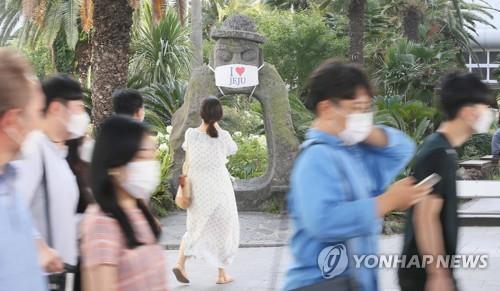
This file photo shows tourists on Jeju Island. (Yonhap)
The latest monthly tally also represented 85 percent of the pre-COVID-19 level of 1.03 million recorded for the same month in 2019. Provincial officials say Jeju's tourist arrivals were rapidly recovering to pre-pandemic levels.
At the same time, however, unknown numbers of coronavirus carriers among tourists are posing a headache to both Jeju residents and quarantine officials.
Eleven of 12 COVID-19 cases confirmed on the island in the first seven days of this month were from visitors from the mainland or Jeju residents who contracted the virus from tourists.
To the dismay of Jeju residents, some infected tourists were found to have come to Jeju despite having suspected symptoms of COVID-19 or learning of infections of fellow workers before entering the island.
"Coronavirus cases are rising among visitors as spring tourism becomes more active in April," a Jeju provincial government official said, urging island residents to observe social distancing rules in dealing with visitors.
A senior official from the Jeju Tourism Organization also said that the authorities of Jeju have no choice but to focus on antivirus measures for now. "Jeju residents are concerned about COVID-19 transmissions from tourists, but they also know well that the island's economy itself will be hit hard if the tourism industry is stagnant," the official said.
[email protected] (END)
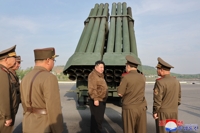
Key S. Korean, USFK special operations officials to hold rare meeting amid N.K. threats

Universities to review measures to exempt boycotting med students from failing semester
- S. Korea, China agree to work for successful trilateral summit with Japan: Seoul ministry
- Instagram overtakes Naver as 3rd most popular mobile app in S. Korea
- Nearly 1,500 kg of drugs seized over past 2 years: customs agency
- Yoon's mother-in-law set free on parole 2 months before end of term
실시간 주요 뉴스 PUSH 알림서비스를 구독할 수 있습니다.

korea joongAng daily
Home > business > industry.

Jeju sours as vacation location with Koreans jetting overseas
![jeju tourist numbers The bustling departure gate of Incheon International Airport for outbound travelers to Japan on Monday. [NEWS1]](https://koreajoongangdaily.joins.com/data/photo/2023/08/09/f5a6ed5f-b755-4e7f-8c0b-69bd5669085c.jpg)
The bustling departure gate of Incheon International Airport for outbound travelers to Japan on Monday. [NEWS1]

More in Industry
Nongshim to make push into French retailers E.Leclerc, Carrefour
Steel stocks soar as U.S. braces for tariff hikes on Chinese imports
Olive oil prices soar 30 percent as climate change ravages Spain's groves
All on the line: Naver has decision to make with $7.3B stake in Line Yahoo
HD Hyundai charity accepting awards nominations for citizens helping others
Related Stories
[WEEKEND GETAWAY] Take a winter break on scenic Jeju Island
Japan bound
Korean airlines add more flights to Japan as demand increases
Jeju's hotels would prefer you to stay on the property
Dolphin discovery
You might also like

To write comments, please log in to one of the accounts.
Standards Board Policy (0/250자)


IMAGES
VIDEO
COMMENTS
Jeju tourism statistics. In 2022, Jeju was still feeling the impact of the pandemic on the travel numbers. While domestic tourists figures weren't affected much, and in fact actually increased (Jeju had the highest number of domestic tourismts ever in 2019 and 2022), the number of foreign tourists reduced drastically. ...
The number of tourists visiting Jeju crossed the 12 million mark in 2021, with 99.6 percent of tourists coming domestically, according to the Jeju Island Tourism Association.. The total number of tourists is still down approximately 20 percent from pre-pandemic numbers, with 15.3 million tourists visiting Jeju in 2019, though it is an improvement from 2020 when the number slumped to just 10.23 ...
The annual number of domestic tourists to Jeju remained in the 8-million range between 2012-2014 and surpassed the 10 million mark for the first time in 2015. ... The tourism industry in Jeju predicted the final 2022 tally to reach 13.8 million by the end of the year, including 13.7 million domestic visitors. ...
South Korea.- According to data from the Jeju Island Tourism Association, the number of tourists visiting Jeju in 2021 exceeded 12 million. However, 99.6 per cent of tourists came from the country. Authorities pointed out that the total number is still down by about 20 per cent when compared to pre-pandemic levels. In 2019, 15.3 million ...
Combined sales of the island's tourism industry came to an estimated 6.34 trillion won (US$4.43 billion) in 2021, up 32.3 percent from the previous year's 4.79 trillion won, the Jeju regional government said, citing data from Statistics Korea. The 2021 figure is more than the corresponding annual sales of 5.7 trillion won recorded in 2017 and ...
All News 16:57 December 02, 2019. SEOUL, Dec. 2 (Yonhap) -- The number of visitors to Jeju Island, South Korea's southern holiday destination, is expected to top 15 million again this year, officials said Monday. According to the Jeju Tourism Association, a total of 13,985,000 tourists arrived in Jeju in the first 11 months of this year ...
The island's best year for tourism revenue was 2019, the same year it had its second-best year in tourism numbers with 15.2 million visitors, with 1.7 million coming from overseas. The best year ever was 2016, just before the THAAD brouhaha, when Jeju welcomed 15.8 million visitors, of whom 3.6 million were foreigners.
Leading tourist attractions in Jeju, South Korea 2022, by number of visitors. In 2022, Cheonjiyeon Waterfall was the most visited tourist attraction in Jeju, South Korea, with around 998.9 ...
According to the data from Jeju's tourism association, 1,089,690 tourists arrived on Jeju from May 1-30. ... Under Level 2, the number of visitors to Jeju's tourist destinations will be limited to ...
The number has consistently increased from 20 flights, which was tallied during the winter season in 2022 after the tourist industry was hit hard by the COVID-19 pandemic, to 123 as of December ...
Jeju Welcome Center, 23 Seondeok-ro, Jeju City, Jeju Special Self-Governing Province 63122, Republic of Korea Tourist inquiries: Jeju Tourism Organization Tel : 064-740-6000~1 FAX : 064-740-6090 Business registration number: 616-82-21432
Jeju Special Self-Governing Province and the Jeju Tourism Organization (CEO Koh Eun-Sook) launched a real-time tourist congestion analysis service in December 2020 that actively utilizes big data technology to help Jeju tourists to enjoy their visit without the need to worry about COVID-19. ... Statistics for the last 24 hours are also ...
As the news sinks in that a second airport will be constructed in Seongsan-eup, southeast Jeju Island, it is clear Jeju tourism has well and truly taken off; what remains unclear is its destination.. With the current airport due to hit capacity by 2018, and the province set on numbers, numbers, numbers, an additional airport was deemed essential for future growth.
Jeju Tourism Organization (JTO) on Sunday said credit card payments in Jeju in 2019 amounted to 4.22 trillion won ($3.74 billion), the highest in recent years. The data was based on Shinhan Card's analysis of consumption patterns of Jeju visitors from 2012 to 2019. ... That number rose to 13 regions throughout Jeju in 2019. Tourists are now ...
The tourism association said the eased virus curbs have triggered growing travel demand. But a full-fledged recovery is still a long way off. The number of visitors to Jeju stood at around 14.31 million in 2018, 15.29 million in 2019. The annual tally dipped to 10.24 million in 2020, when the country confirmed the first local case of the COVID-19.
The Jeju Tourism Organization (JTO) is the official body tasked with the promotion of tourism in Jeju. Now rising from the ashes as one of the regions hit hardest by the COVID-19 pandemic, the JTO is leading Jeju's resurgence as an attractive destination for wellness tourism in 2022. ... The JTO provides a number of public services. These ...
Jeju Welcome Center, 23 Seondeok-ro (Yeon-dong), Jeju City, Jeju Special Self-Governing Province, Republic of Korea COPYRIGHT ⓒ JEJU TOURISM ORGANIZATION. ALL RIGHTS RESERVED.
The mass of islands draping off Korea's southern coast fades into the Pacific, before coming to an enigmatic conclusion in the crater-pocked JEJU ISLAND, known locally as Jejudo (제주도). This tectonic pimple in the South Sea is the country's number-one holiday destination, particularly for Korean honeymooners, and it's easy to see why - the volcanic crags, innumerable beaches and ...
Jeju International Airport ... Number of tourism-related establishments South Korea 2016-2022. Number of establishments in the tourism industry in South Korea from 2016 to 2022 (in 1,000s)
JEJU, South Korea, April 11 (Yonhap) -- A rapid growth in tourist numbers is bringing joy to and causing concern among residents of Jeju, the southern holiday island increasingly favored by locals as an alternative to overseas travel amid the COVID-19 outbreaks.
Table 2 presents the tourist arrival numbers to Jeju Island in recent years. As it is off the Korean Peninsula, it has maintained its interesting and distinctive culture and livelihood heritage ...
According to data from the Jeju Tourism Association, the number of domestic tourists visiting Jeju Island in June decreased by about 186,000, or 14.5 percent, compared to the same period last year. A 32-year-old office worker surnamed Lee, who recently went on a two-night, three-day trip to Bangkok, Thailand, with her husband, chose the nearby ...
Uncover Jeju Island's wonders with our travel guide: from breathtaking volcanic landscapes to serene beaches. Find the best stays, top restaurants, and cozy cafes for an unforgettable experience. Plan your dream Jeju adventure today and dive into the beauty of Korea's island paradise.